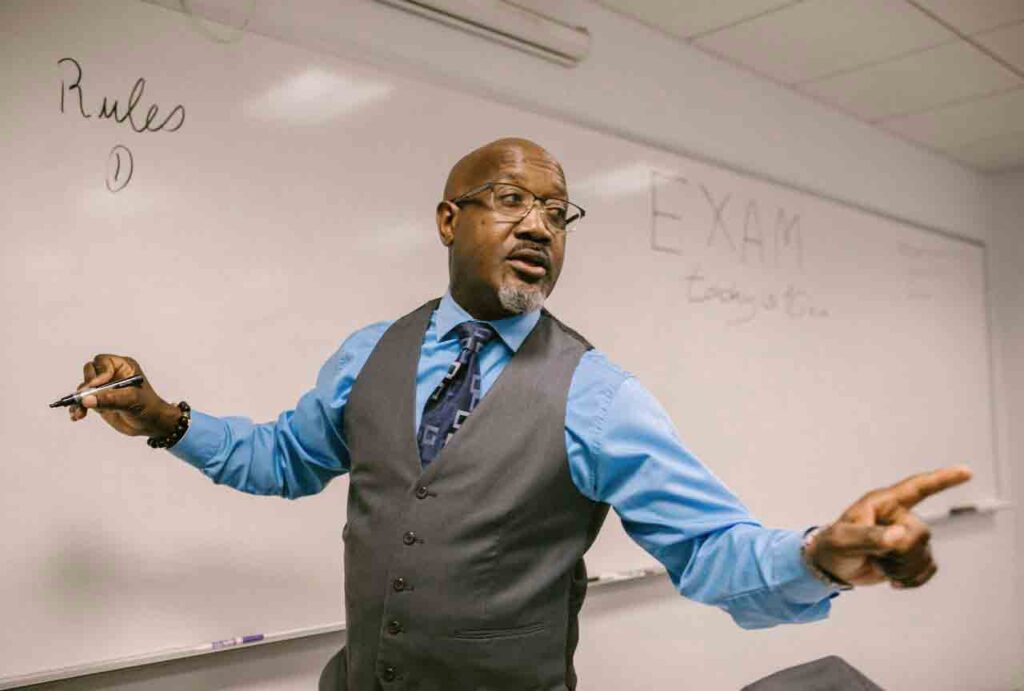Do you want your students to remember you as the most inspiring teacher ever? We cannot forget our best teachers, and you can be one for your students as well. Being a teacher goes beyond delivering lessons, it’s about motivating, engaging, and positively influencing students. Many educators strive to create a learning environment where students not only listen but actively participate, respect, and follow guidance. However, without the appropriate strategies in place, accomplishing this can be difficult.
In today’s classrooms, students are more diverse in their needs and interests than ever before. To truly inspire students and capture their attention, teachers need to implement effective techniques that resonate with different learning styles and personalities.
Grab your pen and take notes as this article provides proven tips and actionable strategies that will help you connect with your students, foster a positive classroom environment, and establish yourself as a respected and inspiring leader. By adopting these practices, you can create a lasting impact that motivates students to engage, follow, and succeed in their academic journey.
1. The Role of a Teacher as a Leader
A critical aspect of being an inspiring teacher is embracing the role of a leader in the classroom. Leadership extends beyond authority; it’s about guiding, motivating, and setting the right tone for learning. Students naturally look for direction, and a teacher’s ability to lead with confidence is key to gaining their respect and attention.
- Set Clear Expectations: As a leader, setting clear expectations is fundamental. Outline both academic and behavioral standards early on so students understand what is expected of them. Clear expectations provide students with structure and help them stay on task. When expectations are communicated effectively, students know what they are working toward and can better follow your guidance.
- Lead with Confidence and Consistency: A teacher’s confidence directly influences how students perceive authority. Confidence doesn’t mean perfection, but it does involve standing firm in decisions, maintaining consistency in rules, and addressing issues directly. Being consistent in classroom management and maintaining a steady presence builds trust. Students are more likely to respect and listen to a teacher who approaches every situation with calm, clarity, and confidence.
- Model the Behavior You Want to See: One of the most effective ways to lead is by example. By consistently demonstrating the behavior you expect from students, such as respect, punctuality, and a strong work ethic, you set a clear standard. Students are more likely to follow your lead when they see these values reflected in your actions. Modeling appropriate behavior helps create an atmosphere of mutual respect and accountability.
2. Build Strong Relationships with Students
To truly be an inspiring teacher, building meaningful relationships with your students is crucial. When students feel valued and understood, they are more inclined to engage, listen, and follow your guidance. Strong teacher-student relationships are the foundation of an effective classroom dynamic.
- Show Genuine Interest in Your Students: Students respond best to teachers who show that they genuinely care about their well-being and progress. Taking the time to get to know students on a personal level, such as their interests, challenges, and learning preferences, fosters trust and rapport. Small gestures like acknowledging student achievements or checking in on their progress demonstrate that you value them as individuals. This connection encourages students to participate more actively and respect your authority.
- Practice Active Listening: Active listening is an essential part of building strong relationships. When students speak, listen attentively, and engage with their thoughts and concerns. Active listening shows students that their opinions and feelings matter, which helps create an open and trusting environment. This practice builds a bridge of communication and encourages students to approach you when they face challenges or need support.
- Maintain Professional Boundaries: While building relationships is important, maintaining professional boundaries is equally essential. Clear boundaries ensure that respect is mutual and that the teacher-student relationship remains professional. Upholding these boundaries establishes a level of authority that students will respect, while still allowing you to connect with them in a meaningful way.

Also Read: 5 Secrets Experts Use To Articulate Their Thoughts Clearly
3. Create a Positive and Inclusive Classroom Environment
Creating a classroom environment where all students feel welcomed and valued is another key to being an inspiring teacher. An inclusive and positive environment fosters engagement and encourages students to take an active role in their learning experience.
- Promote Inclusivity and Respect: Students come from diverse backgrounds and have different learning needs. To create an inclusive classroom, ensure that every student feels respected and included. This involves acknowledging different perspectives, encouraging all students to participate, and being mindful of individual needs. When students feel accepted, they are more likely to engage and collaborate, resulting in a more cohesive learning environment.
- Encourage Collaboration and Peer Support: Encouraging students to work together and support one another builds a strong sense of community. Group activities and peer support systems allow students to share knowledge and skills, fostering collaboration rather than competition. A collaborative environment enhances student engagement and strengthens the bonds within the classroom.
- Use Positive Reinforcement: Positive reinforcement is a powerful tool for creating a motivating atmosphere. Recognizing and rewarding effort, good behavior, and academic achievements encourages students to strive for success. Whether it’s verbal praise, certificates, or class-wide rewards, consistent positive reinforcement helps students associate hard work and good behavior with positive outcomes. This practice also contributes to a more positive classroom climate, where students are motivated to follow rules and meet expectations.
4. Make Learning Engaging and Relevant
To truly be an inspiring teacher, it’s essential to ensure that learning is not only educational but also engaging and relevant to students. When students find the material interesting and applicable to their lives, they are far more likely to pay attention, participate, and retain what they’ve learned.
- Connect Lessons to Real-World Applications: One of the most effective ways to make learning engaging is by relating it to real-world contexts that students can connect with. When students see how the concepts they are learning apply to everyday life, future careers, or societal issues, their motivation to learn increases. Take time to highlight how the subject matter can be used outside of the classroom, whether it’s through current events, future job skills, or practical life applications. This relevance helps students grasp the importance of their studies.
- Use Interactive and Varied Teaching Methods: Engagement also thrives on variety. Incorporating different teaching techniques—such as group discussions, hands-on activities, multimedia presentations, and technology—ensures that students remain attentive and actively participate in lessons. Each student has their preferred learning style, so varying your approach keeps them interested while accommodating these differences. Incorporating movement, debates, and creative assignments can make lessons more dynamic and prevent disengagement.
- Encourage Student Participation and Ownership: Allowing students to take part in their own learning process empowers them and keeps them engaged. Give students opportunities to contribute to lessons through group projects, class presentations, or discussions where their thoughts are valued. By encouraging participation, you build a more interactive environment where students feel a sense of ownership over their learning. When students are involved, they are more motivated to follow through and take their studies seriously.
5. Be Passionate About What You Teach
Being passionate about what you teach is one of the most powerful ways to be an inspiring teacher. Passion not only energizes your lessons but also influences how students perceive the subject. When students see that you care deeply about the material, they are more likely to develop a similar enthusiasm and curiosity.
- Show Genuine Enthusiasm for the Subject Matter: To inspire students, your enthusiasm for the subject should be evident in your teaching. Whether it’s through the tone of your voice, the energy you bring to discussions, or the extra effort you put into your lessons, demonstrating excitement makes a noticeable difference. Students can sense when a teacher is genuinely passionate, and this can ignite their own interest in the subject. Enthusiasm helps create a more engaging learning environment where students feel motivated to participate and explore the material further.
- Continuously Expand Your Knowledge and Skills: Passionate teachers are always eager to learn more about their subject, and this ongoing curiosity should reflect in your teaching. Continuously expand your expertise by staying up to date with the latest developments, research, and trends in your field. This not only ensures that your content is relevant but also keeps your lessons fresh and dynamic. Sharing new insights or discoveries with students keeps them engaged and demonstrates that learning is a lifelong process.
- Transmit Your Passion Through Creative Lesson Delivery: Incorporating creative methods in your teaching further enhances the delivery of your passion. This might include integrating personal insights, experimenting with new teaching techniques, or offering unique perspectives that excite students. When passion is expressed through creativity, it creates a stimulating classroom environment where students are eager to learn. They are more likely to follow a teacher who consistently brings energy, knowledge, and a sense of purpose to their work.

Also Read: How To Give A Killer Presentation And Make a Lasting Impact
6. Provide Constructive Feedback That Motivates
Constructive feedback is one of the most powerful tools an inspiring teacher can use to shape student growth. Feedback, when delivered thoughtfully, helps students understand their strengths and areas for improvement, while also motivating them to continue working toward their academic goals.
- Be Specific and Actionable: For feedback to be effective, it must be specific and provide students with clear, actionable steps for improvement. Avoid vague comments such as “good job” or “needs work” and instead focus on particular elements of the student’s performance. Highlight what they did well and explain why it was effective, then outline the areas where they can improve, offering practical suggestions. Specific feedback allows students to understand exactly what they need to focus on and encourages growth rather than leaving them confused or discouraged.
- Balance Positive and Constructive Comments: Feedback should strike a balance between positive reinforcement and constructive criticism. Acknowledge the student’s efforts and achievements before addressing areas that need improvement. This approach builds confidence and shows students that their hard work is valued, making them more receptive to constructive suggestions. It’s important that students don’t feel overwhelmed by criticism but are instead motivated to apply the feedback and improve their performance.
- Offer Ongoing Feedback and Opportunities for Improvement: Feedback should not be a one-time event. Regular, ongoing feedback allows students to continuously refine their skills and track their progress over time. It’s also important to give students opportunities to act on the feedback provided. For example, offer chances to revise assignments or participate in extra practice sessions to address the areas where they struggled. Continuous feedback paired with opportunities for improvement helps students stay engaged in their learning process and feel supported as they work toward their goals.
Sum up
Being an inspiring teacher means your influence should extend far beyond delivering academic content. It’s about creating an environment where students feel valued, motivated, and empowered to succeed. By embodying the principles of strong leadership, building meaningful relationships, and maintaining an engaging and supportive classroom, you can guide students toward achieving their full potential.
Incorporating these strategies not only improves the learning experience but also leaves a lasting impact on students, inspiring them to listen, participate, and follow your guidance. As a teacher, your ability to inspire comes from your commitment to their growth and success. When students see your passion, feel your support, and understand your expectations, they are more likely to respond positively and reach new heights in their academic journey.



